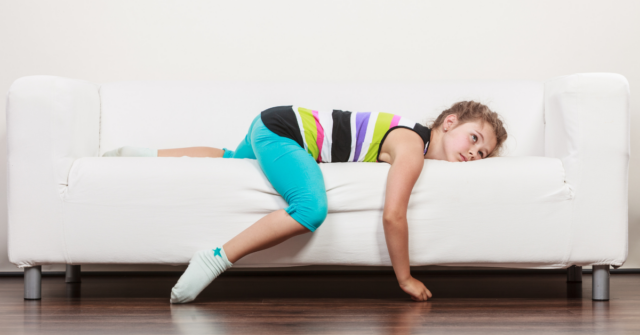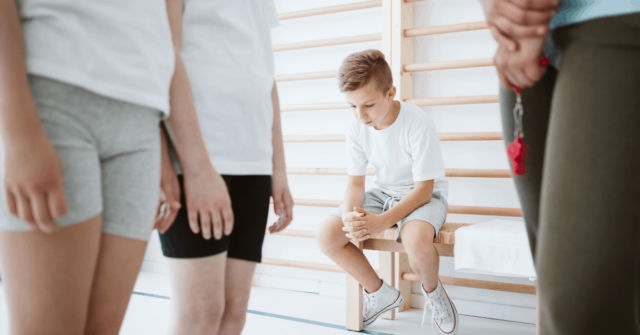Kids that are tired all the time, zoned out, or simply not interested in participating in many activities can get labeled as lazy, but there could be a powerful explanation to this behavior: sensory low registration. Learn what it is, how to know if your child has it, and what to do about it.
He’s slumped in his chair, half folded all over his desk. His head is resting on his arm while the teacher stands in front of the classroom teaching. He’s staring off into the distance and looks like he could fall asleep. His shirt is half tucked in, his pants are twisted, and his hair is messy.
His teacher has tried to give him the benefit of the doubt, but he just seems lazy.
At home, his sisters run outside to play, but he’d rather lay on the couch. His parents make him go to bed early because he always seems so tired, but even with adequate sleep, he clomps around the house and struggles through the school day.
Yet, there are moments, glimpses, of who he really is. Every once in a while, he becomes alert and engaged, but it never seems to last long. Everyone has just about accepted that’s how he is, it’s his personality. His disposition.
But, what if I told you that there could be something more lying beneath the surface, a cause to this tired and uninterested state he’s often in?
Why Are Some Kids Lethargic, Unmotivated, and Spaced Out?
Personality plays a big role in our interactions and how we learn, but a child that consistently is lethargic, unmotivated to participate in activities, and spaced out may have something more going on.
Something they can’t help. Something that isn’t their fault.
It’s called sensory low registration.

What’s This Have to Do With Sensory?
If you’ve never heard that term before, then it likely sounds really strange. Before I get to telling you all about low registration, you first have to know about sensory processing, a critical part of child development and each of our daily experience.
While we don’t think about our brain’s sensory processing, it’s something that’s happening constantly like our heart beat or breathing. Our brain is constantly taking in all the sensations we’re experiencing and processing them. The brain decides what we’re going to respond to and what we’re not. And, this varies a lot from person to person because everybody’s brain is unique.
It’s why you can be in a room with 3 other people and 1 person is immensely bothered by the bright sunlight streaming in, another person loves the bright light, and another didn’t even notice it.
That’s just one example of sensory processing, to learn more head to What is Sensory?
What Is Sensory Low Registration?
Kids can have several types of sensory issues or needs. You might have heard of sensory sensitivities or sensory seeking, low registration is another type of sensory issue and a child can have just low registration or any combination of the three.
Sensory low-registration is when the brain doesn’t process sensations. It’s as if the sensations come in, but get lost on the way. They don’t register or aren’t received in the brain. The brain doesn’t respond. As a result, a child doesn’t notice sensations that others do. And if a child has low registration of the proprioceptive and vestibular senses, which are the most common, they seem tired, spaced-out, and lazy.
In the example above with the bright sunlight in the room, the person that didn’t notice it would be an example of low registration. Not noticing the bright sunlight isn’t a big deal, but low registration can have much bigger affects.
For kids like the little boy who is slumped over in class, tired, and doesn’t want to play, low registration is having an impact on his learning, development, and socialization.

How Do You Know If Your Child Has Low Registration?
If your child has sensory low registration, you’ll see any of the following red flags:
- Described as lazy
- Tired all the time, despite sleeping well
- Never seems to have any energy
- Clumsy
- Runs or walks slowly
- Often seems disorganized
- Doesn’t notice food on their face
- Doesn’t notice their clothes being inside out, twisted, or backwards
- Doesn’t mind or notice bright lights, smells, or tastes
- Messy handwriting
- Tends to “space out” often
- Slouches on furniture, walls, and other people
- Poor posture
Some kids with low registration will have just a few of these signs, others will have many.
Sensory needs are on a wide spectrum. Technically, we all have some sensory needs, what matters is how much they affect our life. Perhaps you see some low registration red flags and it’s the explanation to so many of the challenges your child faces.
If your child is facing A LOT of challenges, they can get evaluated by a local occupational therapist that specializes in sensory integration. Make sure they have that training when you schedule an appointment.
But, if your child has some mild to moderate changes, there’s a lot you can do at home. You’ve already taken a powerful first step in just identifying the underlying issue!
Learn about other Sensory Red Flags.
Can Low Registration Get Better?
Yes! Absolutely, yes.
That’s the great news about any type of sensory processing issue, new connections can be made in the brain when your child participates in specifically designed activities that work to address low registration.
A lot of parents think that any sensory activity they see on Pinterest is beneficial for their child, but that may not be the case. First, you must know what your child’s needs are, in this case, low registration that’s causing fatigue and poor motivation. Then, you learn what types of proven activities will help your child.
How to Improve Your Child’s Low Registration
The key to helping kids with low registration is making the sensations bold enough that the brain can’t help but register them. For overall tiredness, lack of interest, and zoning out, the best way to do that is through quick, fast, and intense movements. Think about jumping up and down as fast as possible, log rolling down a hill, or riding their bike as fast as they can.
Starting and stopping these activities on command, can increase that registration too.
For some kids, participating in these sensory activities before school is all they need to improve their concentration. Some may need those activities scattered throughout their day, in which case, you’ll want to talk to their teacher. Head to 13 Easy Sensory Strategies for the Classroom.
Some other ideas are sucking on something intensely sour or spicy. Taking a sniff of a strong essential oil or touching something cold. Or, playing loud, fast, and erratic music.
Get More Sensory Activities!
Since kids can have a variety of sensory needs. I want to share a list of some of my favorite and most powerful sensory activities with you. If you’re focusing on low registration, try using the movement based activities as quickly as possible on the list. Click below to grab it and we’ll send it right to your inbox!
Click here to get the 25 Powerful Sensory Activities to Calm and Focus Your Child
Learn More About Sensory Processing
The Hidden Reason Your Kid is Super Sensitive, Hyper, or Bad!
3 Ways to Figure Out if Your Kid Has Sensory Over or Under Processing
How to Identify Sensory Issues in Toddlers
5 Smart Sensory Questions Parents Asked: Answered by an OT
Alisha Grogan is a licensed occupational therapist and founder of Your Kid’s Table. She has over 20 years experience with expertise in sensory processing and feeding development in babies, toddlers, and children. Alisha also has 3 boys of her own at home. Learn more about her here.

Do you have suggestions for adults who see these sensory needs in themselves. I see myself in this low sensory processing.
Hey Heather,
Thanks of reaching out. The one reference we do have is: hsperson.com which is more for the adult sensitivities, so hopefully that is a good resource for you!
Best,
Desiree